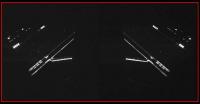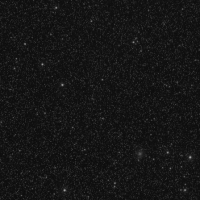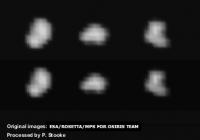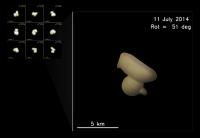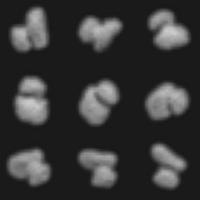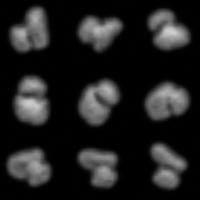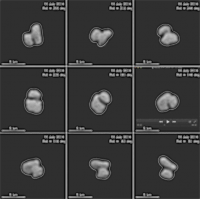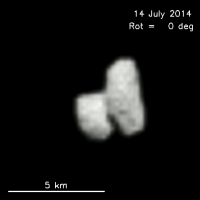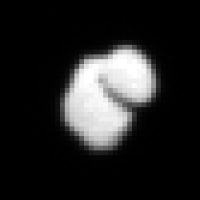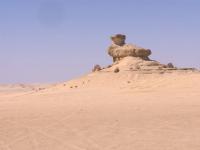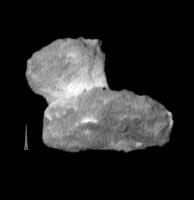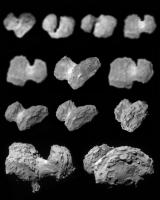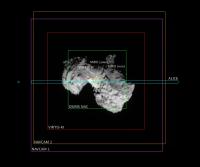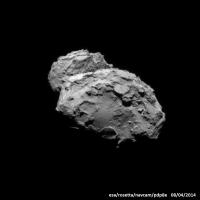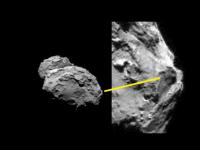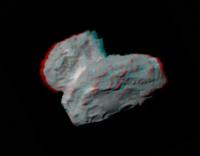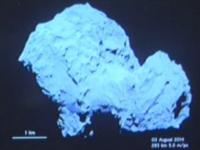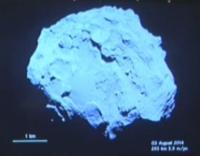Printable Version of Topic
Click here to view this topic in its original format
Unmanned Spaceflight.com _ Rosetta _ Instrument commissioning phase
Posted by: stone Mar 26 2014, 06:23 PM
Today a member of the camera science team put up the first images of the comet on his office door. So the camera works. He said on the image is M107 and the comet could this be?
Posted by: Paolo Mar 27 2014, 01:45 PM
here you go: http://blogs.esa.int/rosetta/2014/03/27/gotcha-rosetta-sets-sights-on-comet/
Posted by: Explorer1 Apr 15 2014, 10:45 PM
Hello again, Rosetta! Glad to see the cameras on Philae are checking out.
http://blogs.esa.int/rosetta/2014/04/15/new-mission-selfie/
Posted by: stone Apr 16 2014, 08:48 AM
I talked to a few engineers today and they say they are in the middle of the Lander checkout.
Posted by: elakdawalla Apr 21 2014, 06:42 PM
At a member's suggestion I've now created a dedicated Rosetta subforum. This should now be the active thread for Rosetta discussion. Instrument commissioning is almost over and there hasn't been much discussion, so this thread may morph into the comet approach thread.
Everybody should be reading http://blogs.esa.int/rosetta/ for detailed updates on the mission status; most are written by Emily Baldwin (Space Science Editor for ESA Portal, also @esascience). Including the attached new CIVA selfie, which is cooler in theory than in fact (it's low-res and awfully JPEGgy)
Posted by: machi Apr 21 2014, 10:43 PM
French organization http://smsc.cnes.fr/ROSETTA/GP_actualites.htm is also good source of news about Rosetta.
Here is for example color test image from Philae's ROLIS camera:
http://smsc.cnes.fr/IcROSETTA/results/Rolis_MLI_2014_04.png
On the image is Rosetta's Multi Layer Insulation.
Here is spectrum from Ptolemy:
http://smsc.cnes.fr/IcROSETTA/results/Ptolemy_2014_04.png
Posted by: Explorer1 May 15 2014, 07:22 AM
http://blogs.esa.int/rosetta/2014/05/14/rosetta-instruments-ready-for-action/
New pictures of C-G will be released soon.
Posted by: Bjorn Jonsson May 15 2014, 12:15 PM
And new images have been posted:
http://www.esa.int/Our_Activities/Space_Science/Rosetta/Rosetta_s_target_comet_is_becoming_active
In short: The comet has started showing a lot of acticity and now has a clear coma. This mission is now getting really interesting to follow...
Posted by: MahFL May 15 2014, 01:20 PM
Also a reminder of how hot the Sun is.
Posted by: brellis May 21 2014, 06:51 PM
The "Big Burn" is going very well, according to the Big Burn https://twitter.com/hashtag/BigBurn?src=hash. ![]()
Posted by: nprev May 21 2014, 09:25 PM
Eight hours??? Wow!
Could anyone in the know explain why they chose this strategy instead of a bunch of smaller burns done earlier? Is this perhaps an engine duty-cycle thing or something like that?
EDIT: Or perhaps this is done now to facilitate a faster overall journey to the comet?
Posted by: Holder of the Two Leashes Jun 4 2014, 02:34 PM
https://twitter.com/hashtag/Bigburn2?src=hashhas started.
Posted by: jamescanvin Jun 5 2014, 07:48 AM
http://blogs.esa.int/rosetta/2014/06/05/big-burn-2-complete/
Posted by: centsworth_II Jun 5 2014, 12:10 PM
Posted by: Phil Stooke Jun 5 2014, 01:04 PM
Also, if you save up all that delta-v and just do one big burn you have little or no chance to fix any problems - an unexpected safing event for instance. Doing it in several steps lets you recover from any problems more easily.
The first two burns were by far the biggest. With them done successfully, it should be fairly smooth sailing now. And I would think we would be resolving the nucleus very soon. I am so looking forward to the first disk-resolved images.
Phil
Posted by: machi Jun 5 2014, 05:04 PM
OSIRIS will resolve nucleus at the beginning of July. In time of fifth burn (2.7.) Rosetta will be ~52 000 km from the comet and resolution will be ~ 1 km/pix (few image elements across cometary disc).
Posted by: MahFL Jun 6 2014, 11:49 AM
From the website
"Note: In fact, this variability in the actual thrust delivered versus what's planned is one of the reasons why the required orbit corrections are being done in a series of smaller burns. Any variation in one burn can be made up in the next, helping the entire process to be more efficient and optimise the use of fuel."
Posted by: Explorer1 Jun 17 2014, 08:07 PM
Big burn coming tomorrow:
http://blogs.esa.int/rosetta/2014/06/17/the-big-burns-part-3/
According to a reply on one of the comments there will be new images this week.
Less than one LD to go!
Posted by: Paolo Jun 19 2014, 12:23 PM
Churyumov-Gerasimenko on 4 June. quieter than before
http://www.esa.int/Our_Activities/Space_Science/Rosetta/Rosetta_s_comet_expect_the_unexpected
Posted by: MahFL Jun 19 2014, 03:12 PM
Is going quieter normal, and will it impact the mission ?
Posted by: djellison Jun 19 2014, 03:13 PM
Normal? Yes.
Impact the mission? No.
Posted by: Paolo Jun 22 2014, 11:22 AM
it's time we start taking bets...
will the nucleus look http://en.wikipedia.org/wiki/67P/Churyumov%E2%80%93Gerasimenko#mediaviewer/File:67PNucleus.jpg or http://www.aanda.org/articles/aa/full_html/2012/12/aa20116-12/F5.html?
Posted by: Phil Stooke Jun 22 2014, 04:02 PM
OK, I'll go first. The old shape model, the first you linked to, is too symmetrical for my taste... I'm pretty sure that is an artifact of the modeling. So I vote for the second one. A digital Mars Bar to everybody if I'm wrong.
Phil
Posted by: JohnVV Jun 22 2014, 08:02 PM
well i did post a celestia SPICE add on for this
in this thread
http://forum.celestialmatters.org/viewtopic.php?f=18&t=578
it is a synthetic noise added
http://www.imagebam.com/image/f50b75302911862 http://www.imagebam.com/image/7c7966302911878
The Original shape file
ftp://naif.jpl.nasa.gov/pub/naif/generic_kernels/dsk/churyumov-gerasimenko/
and
ftp://naif.jpl.nasa.gov/pub/naif/generic_kernels/dsk/churyumov-gerasimenko/input_files/
imported into blender
http://forum.celestialmatters.org/viewtopic.php?f=4&t=618
http://www.imagebam.com/image/c86760302732191
and the .obj file ( rotated to match the above plate file )
http://www.imagebam.com/image/b073c5302733121 http://www.imagebam.com/image/a4a65f302740136
Posted by: djellison Jun 22 2014, 08:16 PM
We'll find out when we get there. Once that happens, perhaps there can be a meritorious discussion on the various means of establishing a shape model from light curves and how well they match the actual nucleus.
Posted by: Explorer1 Jun 25 2014, 03:48 PM
http://blogs.esa.int/rosetta/2014/06/25/comet-67pc-g-in-rosettas-navigation-camera/
Posted by: Phil Stooke Jun 25 2014, 06:05 PM
Right, and see the associated note about data availability.
Phil
Posted by: JohnVV Jun 25 2014, 06:38 PM
so in January/February we might have access to the data ,other than published news
Posted by: djellison Jun 25 2014, 06:45 PM
I would urge caution in interpreting any data release schedule. The only thing we've learned over the 11 years since launch is that most of the instrument teams are in no hurry at all to release their data.
Posted by: elakdawalla Jun 25 2014, 06:57 PM
I have high hopes that at least the NAVCAM data will be available on that timeline, and today's release shows it'll be fun to play with. The distant approach phase is much more fun for a comet than it is for an asteroid, for sure!
Posted by: elakdawalla Jun 26 2014, 03:52 PM
http://sci.esa.int/rosetta/54220-comet-67pc-g-in-rosettas-navigation-camera/ as individual JPEGs (http://sci.esa.int/science-e/www/object/doc.cfm?fobjectid=54219). I spent a little while trying to make an animation where the background was black and star density nearer constant but couldn't produce anything I was happy with.
Posted by: dilo Jun 26 2014, 09:56 PM
Emily, I tried too changing luminosity/contrast but resulting movie, reported below, isn't good... at least, it shows the increasing luminosity of approaching nucleus:
Note: I used only 11 frames and cropped field in order to have a small GIF to upload.
Posted by: Gerald Jun 27 2014, 01:54 AM
That's the closest I could get within a few hours:
http://imgur.com/tBSsi5i
The gif is reduced to 660 pixels to fit into the 2 MB limit (I think) of imgur.
I've used the average brightness of the images as brightness calibration, after subtracting the minimum brightness (RGB channel-wise) over all images (removes vertical streaky artifacts).
Then I (actually a quick and dirty written piece of software) subtracted the minimum brightness (again each RGB channel) over the thus far processed first 21 images to partially clean the images from camera artifacts. This latter processing step probably reduced the brightness of CG a bit more than intended in the beginning of the sequence, but using all images instead has no noticible cleaning effect at all.
I guess, that the overall dark raw images at the end of the sequence cause the flickering, when using the calibration method sketched above; but I had no better easy-to-implement idea.
Posted by: dilo Jun 27 2014, 04:52 AM
Great animation, Gerald! It would be nice to change frames duration in order to have a constant star speed...
Posted by: Gerald Jun 27 2014, 01:14 PM
Good idea!
Here versions for roughly 5 ms and 2.5 ms per vertical pixel motion, hence no constant frame rate:
http://imgur.com/rBp9WXJ http://imgur.com/ckfx2aK
(The 2.5 ms-per-vertical-pixel version may be challenging for some computers.)
Looks like some frames would be missing; those gaps could be filled by interpolated frames, I didn't do so.
Posted by: xflare Jun 27 2014, 01:16 PM
Did anyone watch the google hangout?
From here they talk about image release policy. http://youtu.be/Ey0UedaFaMs?t=38m25s
Posted by: Phil Stooke Jul 1 2014, 12:39 PM
Getting closer!
Where is Rosetta? On 01 July 2014 Rosetta is 58,557 km from comet 67P/C-G and getting closer.
(ESA: http://sci.esa.int/home/ )
Phil
Posted by: Paolo Jul 3 2014, 02:30 PM
first hints of a shape
http://blogs.esa.int/rosetta/2014/07/03/the-comet-takes-shape-one-pixel-at-a-time/
Posted by: dilo Jul 3 2014, 03:50 PM
Processed versions of June, 27 image (de-pixelized through gaussian filter, then false-colors):
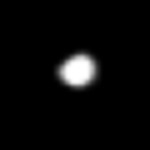
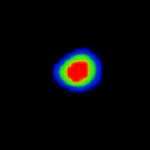
If my figures are right, based on Osiris Narrow-angle http://www.planetary.org/explore/resource-library/data/rosetta-osiris.html (0.0186 mrad/pixel) and on the distance, image resolution is 1.6km/pixel, so the nucleus is probably over-exposed because its true image should measure a couple of pixel while it appears 3 times larger...
Posted by: xflare Jul 3 2014, 04:03 PM
hmm based on the public comments here http://www.bbc.co.uk/news/science-environment-28146472 ESA might need to release more images. Although for people with a casual or little interest in the mission, an occasional image each week is probably sufficient. ![]()
Posted by: Paolo Jul 3 2014, 04:14 PM
from http://blogs.esa.int/rosetta/2014/06/25/comet-67pc-g-in-rosettas-navigation-camera/
I have a bad feeling about this... I think we are going to see another wave of "why they don't share all their images in real time" like we last saw in December for Chang'e 3.
Posted by: Ron Hobbs Jul 8 2014, 04:24 PM
This is neat image from the Rosetta folks. One of the things I like to do in my outreach talks is give a sense of scale. This is an informative graphic in that regard.
It really is a flying mountain of ice and dust.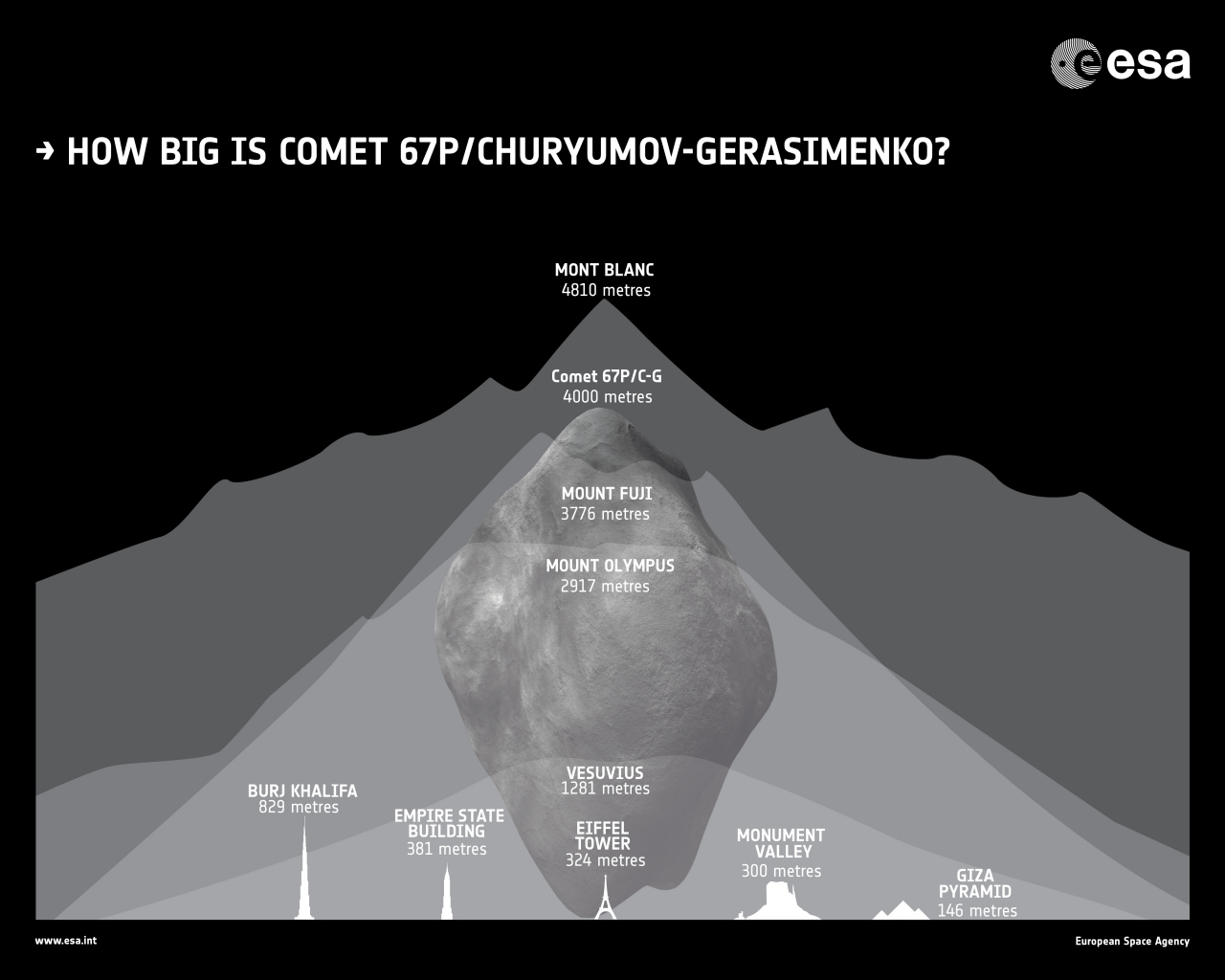
Posted by: Bjorn Jonsson Jul 10 2014, 01:25 PM
New images obtained on July 4:
http://blogs.esa.int/rosetta/2014/07/10/the-three-faces-of-rosettas-comet/
The comet's shape is starting to become apparent. Not unexpectedly, it's at least a bit irregular. Referring to the end of the text in the above link, I get the impression that it is more round/lumpy than long/skinny but I'd really like to know the phase angle in these images.
Posted by: dilo Jul 10 2014, 02:01 PM
Thanks Bjorn for highlight.
Here below my processed version with gaussian de-pixelization and false-color coding... to me, it appear a tri-lobate shape (vaguely recalling a water molecule!) but we need to go a little bit closer to be sure.
Posted by: Phil Stooke Jul 11 2014, 04:18 PM
Despite the appearance of complete over-exposure on the nucleus, there is some subtle detail which can be brought out by careful processing. But it may be spurious! - so you can't really interpret anything from it.
Phil
Posted by: Gerald Jul 11 2014, 05:46 PM
One more try, just to stimulate imagination, will be obsolete within a few days, certainly:
The rotation axis looks a bit like to be pointing almost horizontally (tilt between 20 and 25°), like indicated by the tentative green line:
Posted by: xflare Jul 11 2014, 07:19 PM
With those images being taken a week ago, I would bet they are probably resolving surface features now.
Posted by: MahFL Jul 14 2014, 12:19 PM
Shouldn't we have a new topic ?, we are past the commissioning phase.
Posted by: elakdawalla Jul 14 2014, 01:36 PM
This thread isn't very full yet, though it might need renaming to include approach imaging. I think it would make sense to start a new thread at the official date of the Mapping Phase, which is given http://starbrite.jpl.nasa.gov/pds/viewMissionProfile.jsp?MISSION_NAME=international+rosetta+mission as August 18.
| Phase |Start Date|Main Event| End Date |Dur |SunDist(AU)|
|=================|==========|==========|==========|====|===========|
{snip}
|-----------------|----------|----------|----------|----|-----------|
|Cruise 6 (DSHM) |14/07/2011| |22/01/2014| 917| 4.49-5.29 |
|-----------------|----------|----------|----------|----|-----------|
|Rendez-vousMan2 |23/01/2014| |17/08/2014| 206| 3.53-4.49 |
| ->RVM2 | |23/05/2014| | | |
|-----------------|----------|----------|----------|----|-----------|
|Global Mapping |18/08/2014| |19/10/2014| 63 | 3.15-3.53 |
|and Close | | | | | |
|Observation | | | | | |
|-----------------|----------|----------|----------|----|-----------|
|Lander Delivery |20/10/2014| |16/11/2014| 28 | 2.97-3.15 |
|->Lander Delivery| |11/11/2014| | | |
|-----------------|----------|----------|----------|----|-----------|
|Comet Escort |17/11/2014| |31/12/2015| 410| 1.24-2.97 |
'-------------------------------------------------------------------'
Posted by: Paolo Jul 15 2014, 02:33 PM
***jaw drops!!!***
http://www.planetary.org/blogs/emily-lakdawalla/2014/07150633-quick-rosetta-update.html
https://www.youtube.com/watch?v=uQ9odfxkfRs
Posted by: Gerald Jul 15 2014, 02:56 PM
This is really wow!
I've taken this into account for a few seconds, and then ruled it almost out due to the rapid rotation, but missed to verify my presumption.
I'm sure it's now possible to calculate an estimate of the lower bound for the density of the comet not to break apart into a true binary.
... Which one is Churyumov, and which is Gerasimenko?
Posted by: charborob Jul 15 2014, 03:06 PM
http://www.planetary.org/blogs/emily-lakdawalla/2014/07150633-quick-rosetta-update.html
https://www.youtube.com/watch?v=uQ9odfxkfRs
The YouTube video has been removed, and also the CNES page referenced in Emily's blog post.
Try http://autourduciel.blog.lemonde.fr/2014/07/15/lincroyable-noyau-double-de-la-comete-67p-churyumov-gerasimenko/ (in French). A Google search for "double nucleus Churyumov" should turn up other references.
Posted by: dilo Jul 15 2014, 03:46 PM
Hey, I think IAU could seriously consider your naming proposal!
anyway, from these first images both objects seems to have the same specular symmetry... incredible amazing nucleus, for sure!
Posted by: Bjorn Jonsson Jul 15 2014, 03:53 PM
Wow, this is going to be an even more interesting mission than I was expecting. Interestingly, there are hints of the two components in Phil's and Gerald's heavily processed versions of the earlier images (although it was impossible to tell back then exactly what the images were showing).
Suddenly the comet's 'long' name has become much better and more appropriate than before.
Posted by: Explorer1 Jul 15 2014, 04:20 PM
Still nothing on the official ESA pages, or twitter for that matter! The video gas been removed from YouTube too...
I always wondered about the view from something like that trojan Hektor, and how it would be decades before anyone landed on something; guess it won't be that long after all!
Posted by: nprev Jul 15 2014, 04:42 PM
Things could get VERY interesting dynamically when Rosetta achieves orbit. I wonder where the barycenter of the two 'lobes' is gonna turn out to be, esp. if there's a significant difference in density or internal material distribution between them. Might facilitate determining the internal structure of each quite a bit.
Posted by: Explorer1 Jul 15 2014, 05:10 PM
Don't forget that now we have an unexpected choice of landing, and Philae's anchors are looking (ironically) like a liability! No hopping around!
Just let it be somewhere in view of both components; it would be straight out of science fiction. Just serves to show how bizarre things can get in places of such low gravity.
Posted by: Phil Stooke Jul 15 2014, 05:24 PM
There is a lot of interesting detail hidden in the bright areas. I'm not posting anything now, but if you can play with images, have a look. I will not post until an official release is available.
Phil
Posted by: Phil Stooke Jul 15 2014, 07:19 PM
For a preview of surface views on a contact binary, you might enjoy these images from NEAR at Eros - not on the surface, but the low altitude makes it look similar.
Phil
http://near.jhuapl.edu/iod/20010108/index.html
http://near.jhuapl.edu/iod/20001212/index.html
Posted by: Bjorn Jonsson Jul 15 2014, 07:53 PM
I see something that might possibly be hints of at least one big topographic feature (crater?) or a big albedo feature.
Posted by: Harder Jul 15 2014, 08:02 PM
To follow on from nprev's comment:
This may actually be good news for the Philea lander: it’s design was premised on a 40-fold lower gravity on the originally targeted comet 46P/Wirtanen.
On the other hand the odd shape of 67P-/CG that has now been revealed may pose a major new hurdle for the nav team: the nav camera’s must be able to keep the Philea landing ellipse in view at all time.
Exciting times ahead.. dictated by orbital mechanics Rosetta inexorably moves towards its destination (is “destiny” too much to say here?) and the Rosetta team has no spare time to park the issue and study it at length. Or perhaps this is already one of their pre-worked scenario’s - let's hope so!
Posted by: Hungry4info Jul 15 2014, 08:27 PM
will the nucleus look http://en.wikipedia.org/wiki/67P/Churyumov%E2%80%93Gerasimenko#mediaviewer/File:67PNucleus.jpg or http://www.aanda.org/articles/aa/full_html/2012/12/aa20116-12/F5.html?
Looks like we were all in for a surprise
Posted by: Explorer1 Jul 15 2014, 09:45 PM
Animated GIF by someone on the blog post:
http://i.imgur.com/4mClCsN.gif
Posted by: JohnVV Jul 15 2014, 10:13 PM
well at least it is somewhat triangular the "lightcurve" shape file is a rough fit
Posted by: Astro0 Jul 15 2014, 11:20 PM
I did play with that last image.....amazing!
Sorry, had to be done. Now moving on....
Posted by: JohnVV Jul 16 2014, 01:21 AM
the FIRST thing that came to mind is a line from a old 1962 comedy LP ( vinyl ) "the first family"
and a quote from it
"... and the rubber ducky is mine"
Posted by: Ron Hobbs Jul 16 2014, 04:45 AM
Looks like we were all in for a surprise ![]()
[/quote]
That is why we explore!
Posted by: Paolo Jul 16 2014, 06:55 AM
another http://www.cieletespace.fr/node/12004
the most interesting sentence states that two imaging sequences are now expected every week.
meanwhile, the Rosetta blog has http://blogs.esa.int/rosetta/2014/07/15/the-third-fat-burn/ on the latest braking burn
Posted by: nprev Jul 16 2014, 07:44 AM
Just thought of an exciting possibility: What are the odds that the two lobes had significantly different histories before 'bonding', as in formed in different areas of the primordial nebula?
Probably not likely. However:
- The formative collision had to happen at fairly low relative velocity. That argues that they were neighbors, quite possibly siblings during their formation.
-Conversely, CG is now an inner Solar System object, and it most likely did not form in what is effectively our neck of the woods.
--If they formed in the Oort Cloud as neighbors & bonded, then they're stuck together real well since they almost certainly had to survive at least one encounter with Jupiter to achieve CG's present orbit.
--If they met & stuck together at or near where they are now heliocentrically, then they could have formed at different locations in the Oort. However, ending up in this state would be amazingly unlikely.
--Still, it seems at least as unlikely that they are fragments of an original object that calved during a close passage & subsequently reunited since they'd tend to drift apart due to independent outgassing events at the very least.
Bottom line here is that we've seen that a contact binary asteroid in the main Belt is not unusual because relative velocities are low between most of these objects. A contact binary comet in the same region does seem unusual, unless CG is an intermediate object between those two classes that formed in the inner Solar System.
Lots of interesting possibilities, and no doubt many future surprises ahead. This is gonna be a really, really fascinating mission. ![]()
Posted by: Gerald Jul 16 2014, 11:18 AM
http://en.wikipedia.org/wiki/Law_of_large_numbers make the unlikely happen.
Throw one dart; how likely is it to hit Bull's Eye from 5 meters distance?
Now repeat the same experiment 10,000 times.
From the large number of Oort objects and the http://en.wikipedia.org/wiki/Chaos_theory nature of http://en.wikipedia.org/wiki/N-body_problem like our solar system, a large number of scenarios are possible.
I'm sure we'll learn things we didn't anticipate, each of the next weeks.
The two parts look different in their shape: While the larger component is going to get a lenticular appearance with possibly a deep valley or a small third component, the smaller one seems to be more similar to a cube, possibly heavily cratered.
The roughly lenticular shape of the larger component might be the result of rotation during formation, whereas the smaller one may have rotated less, but may have experienced more collisions.
This is totally preliminary today, and we'll know much more within days.
Posted by: Gerald Jul 16 2014, 02:38 PM
http://blogs.esa.int/rosetta/2014/07/16/access-to-rosetta-data/:
Posted by: Phil Stooke Jul 16 2014, 04:54 PM
I think the "unscheduled" release has been so widely distributed now that I can show my processing of it.
Phil
Posted by: Gerald Jul 16 2014, 05:18 PM
That's one of my processed versions
and as animation:
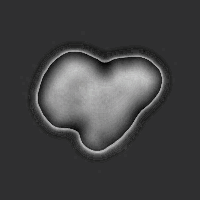
Credit for the raw images: ESA / Rosetta / MPS for OSIRIS Team MPS / UPD / LAM / IAA / SSO / INTA / UPM / DASP / IDA
Posted by: Astro0 Jul 16 2014, 11:29 PM
An animation of Phil's processed images with interframes to smooth out the action ![]()
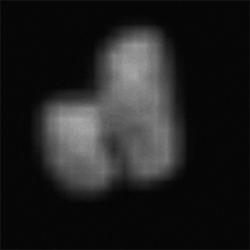
Credit for the raw images: ESA / Rosetta / MPS for OSIRIS Team MPS / UPD / LAM / IAA / SSO / INTA / UPM / DASP / IDA
Posted by: nprev Jul 16 2014, 11:40 PM
Is it just me, or does it look like the nucleus is precessing as well as rotating?
Posted by: eoincampbell Jul 17 2014, 01:50 AM
So exciting, this is shaping up to be a rewarding mission... ![]()
Posted by: Phil Stooke Jul 17 2014, 02:27 AM
nprev, it's hard to tell from just one jerky rotation, but that might be possible. A slow rotator lacks the ability to stabilize its rotation axis so it can precess dramatically - asteroid Toutatis is a well-known example, comet Halley is another, and Saturn's moon Hyperion may be another (rather than chaotic as often stated, but this is perhaps still uncertain).
With a reported rotation period of more than 12 hours this might be another example, but I am not sure about that. We can't be looking down the rotation axis because of the changing shape, and we are not looking at the equator because features would just track side to side. I think we are viewing within about 20 degrees of 45 degrees latitude. That might be enough to account for the changing appearance.
Phil
Posted by: Gerald Jul 17 2014, 07:52 AM
http://en.wikipedia.org/wiki/Precession#Torque-free wouldn't be quite unexpected for a rigid, asymmetric body. But rotation period and precession period could well be no multiples. In this case we should note a jump in the motion (repeating the one-period loop).
Posted by: machi Jul 17 2014, 01:03 PM
New images are out:
http://blogs.esa.int/rosetta/2014/07/17/the-dual-personality-of-comet-67pc-g/
Posted by: Paolo Jul 17 2014, 01:03 PM
and finally, an official release from ESA:
http://blogs.esa.int/rosetta/2014/07/17/the-dual-personality-of-comet-67pc-g/
Posted by: Mercure Jul 17 2014, 02:15 PM
Interesting to read the different hypotheses regarding the shape, in the official ESA release:
1) two comets melding together
2) single comet gravitationally tugged into curious shape
3) ice evaporation
4) near-catastrophic impact
- We'll all be much wiser later on...
Posted by: machi Jul 17 2014, 02:42 PM
This is slightly changed version of the published animated gif. I've only added one synthetic frame (between 338° and 0°), changed speed and contrast and gamma.
(Credit for the raw images: ESA / Rosetta / MPS for OSIRIS Team MPS / UPD / LAM / IAA / SSO / INTA / UPM / DASP / IDA)
Posted by: Gerald Jul 17 2014, 03:12 PM
http://www.esa.int/spaceinimages/Images/2014/07/Rotating_view_of_comet_on_14_July_2014 grabbed and tiled:
http://imgur.com/JQroNdm
http://postimg.org/image/4tb1erbxl/full/.
Posted by: Gerald Jul 17 2014, 05:04 PM
Here a heavily processed version of the tiles, enhancing small features:
http://imgur.com/3frCQ0e
A tentative identification of some of the most distinct surface features in crops of these processed tiles:
Posted by: elakdawalla Jul 17 2014, 05:24 PM
Be careful. ESA posted an image that shows you the original resolution of the data. Most of the features that you've identified are barely more than one pixel across.
Posted by: JohnVV Jul 17 2014, 06:17 PM
also that animation looks like it is FULL of jpg artifacts
Posted by: wildespace Jul 17 2014, 06:31 PM
What are the chances of this comet disintegrating when close to perihelion. Could these two pieces come apart?
Posted by: ynyralmaen Jul 17 2014, 06:43 PM
Application of a data scrubbing algorithm yields surprising results...
Posted by: Paolo Jul 17 2014, 07:55 PM
the German DLR space agency has a large mosaic on its website:
http://www.dlr.de/dlr/presse/en/Portaldata/1/Resources/bilder/portal/portal_2014_3/CG_Mosaik.jpg
Posted by: Gerald Jul 17 2014, 09:16 PM
I've been aware, that it's close the limit of the resolution, and first have been skeptical, too. For this I've first smoothed the image by a 1.5 pixel Gauss blur, before applying a 5 pixel hipass filter, to later enhance the image.
Before identifying feature candidates I've checked, whether they occur in at least two images. The usual averaging technique to beat down noise doesn't work easy here, because the perspective changes with each image.
Here the valley candidate as an example (crop of the DLR image) :
(could also be an elliptical crater or two overlapping craters)
Of course, there is still a risk, that some is an artifact, but it should reduce exponentially with the number of images a feature occurs.
Posted by: djellison Jul 17 2014, 10:31 PM
It's been in it's current orbit for about 55 years - or nearly 9 perihelion passes. It's not broken apart yet.
Posted by: Ron Hobbs Jul 17 2014, 11:53 PM
I guess we will just have wait and see, won't we.
And, darn it, I cannot get that song out of my head.
"Rubber duckie, your the one ...."
Posted by: MarsInMyLifetime Jul 18 2014, 12:04 AM
If you've seen Camel Rock Monument in northern New Mexico, you may be wondering if the camel has a counterpart in space: http://www.scenicusa.net/083012.html
Posted by: belleraphon1 Jul 18 2014, 01:22 PM
Call for media: Rosetta’s comet rendezvous on August 6th
http://blogs.esa.int/rosetta/2014/07/18/call-for-media-rosettas-comet-rendezvous/
Posted by: Harder Jul 19 2014, 12:41 PM
New Mexico? How about this one from the Libya desert, due South from Marsa El Brega on the road to Attahadi. It’s living proof that Nature is capable of stunning Duck renditions. An appetizer for what is yet to come from the Rosetta team?
Posted by: Gerald Jul 20 2014, 08:22 PM
A couple of parallel-eyeds based on the http://www.dlr.de/dlr/presse/en/Portaldata/1/Resources/bilder/portal/portal_2014_3/CG_Mosaik.jpg:
Posted by: TheAnt Jul 22 2014, 12:29 PM
I agree with the idea it look a little bit like a rubber duck.
And I have to agree, we cannot say any features are seen from just single pixels in any images.
So just take a deep breath and wait a few more days for details to appear. =)
Posted by: machi Jul 24 2014, 01:29 PM
http://blogs.esa.int/rosetta/2014/07/24/hints-of-features/ from Rosetta!
Credits: ESA/Rosetta/MPS for OSIRIS Team MPS/UPD/LAM/IAA/SSO/INTA/UPM/DASP/IDA
Posted by: Gerald Jul 24 2014, 02:19 PM
A strongly enhanced version:
From the blurred scale you may approximately estimate the resolution.
Posted by: machi Jul 24 2014, 02:31 PM
We know distance (~5500 km) so resolution is slightly over one hundred meters per pixel (102-103 m/pix).
Images on the ESA's site are 8× magnified.
Posted by: dilo Jul 24 2014, 03:52 PM
If you pay attention to last frame, there is a "welding" flat region between the two portions, made of darker material compared to the bright ring all around the contact; my impression about the "white collar" is that it could be made of fresh material exposed during last passages, when volatile substances (previously filling the gap between the two portions) sublimated; obviously, this idea is highly hypothetic! Only spectral analysis, joined to high-resolution morphology, could help to confirm or not this model...
Posted by: nprev Jul 24 2014, 05:14 PM
Given the processing & enhancement done to these images & their size in pixels, is the resolution sufficient yet to determine if the albedo differences Dilo noted are real? For example, the bright 'ring' at the lobe contact point in particular sure looks like it might be specular; maybe the rest of the surface appears just as bright from the right illumination angles.
Posted by: Phil Stooke Jul 24 2014, 05:22 PM
Very nice new images - here's a differently processed version.
Phil
Posted by: Explorer1 Jul 24 2014, 05:30 PM
Looks like new NAVCAM's will be given out daily from now to arrival. Better than OSIRIS weekly I suppose?
Posted by: Phil Stooke Jul 24 2014, 05:50 PM
The shape model is interesting as well. It may be obvious to people but I should point out that the small peaks are artifacts - they are produced by the spatial interpolation process which converts a sparse set of points to a full DEM.
Phil
Posted by: JohnVV Jul 24 2014, 06:59 PM
-- edit-
this is the OLD light curve shape file
are you referring to the nasa/jpl/naif shape file
http://www.imagebam.com/image/b073c5302733121
-- the NEW one ( early look)
the animation on the esa page
http://www.esa.int/spaceinimages/Images/2014/07/Shape_model_of_comet
Posted by: Phil Stooke Jul 24 2014, 07:57 PM
The one just released by ESA, which contains several little spiky hills. I don't want people thinking they are real - for one thing the model is based on the earlier set of images with very low resolution. For another, most of the 'hills' are on the outer edge of the 'big end', which was hardly visible in the images because of the viewing angle.
Phil
Posted by: Phil Stooke Jul 24 2014, 08:03 PM
This is more like the real resolution of the data. Not to deny the fantastic job the science team has done with such early data. I am only saying the high resolution rendering can't be relied on in every detail.
Phil
Posted by: Gerald Jul 24 2014, 09:31 PM
There isn't a final assessment yet, but dilo's hypothesis is well on the same line as the science team considers as likely.
http://www.mps.mpg.de/3692726/PM_2014_07_24_Rosetta-Komet_Ein_Blick_auf_die_Oberflaeche :
Auch wenn die aktuellen Bilder, die aus einer Entfernung von 5500 Kilometern entstanden, noch nicht hochaufgelöst sind, erinnern sie die Wissenschaftler an den Kometen 103P/Hartley. Die NASA-Mission EPOXI hatte diesen Körper 2010 im Vorbeiflug besucht. Während die Enden des länglichen Kometenkerns eine raue Oberfläche aufweisen, erscheint die Mitte glatter. Forscher glauben, dass sich in dieser Taille Material ablagert, das zunächst emittiert wurde, dann aber den Einfluss des Schwerefeldes des Kometen nicht verlassen konnte. Im Bereich der Taille befindet sich der Masseschwerpunkt von 103P/Hartley.
Ob diese Überlegungen auch auf den Halsbereich von 67P zutreffen, ist noch unklar. Eine andere Erklärung für eine hohe Reflektivität in diesem Bereich könnte eine andere Oberflächenzusammensetzung sein. Das OSIRIS-Team hofft, in den nächsten Wochen spektrale Daten des Kamerasystems zu erhalten. Mit Hilfe verschiedener Filter kann OSIRIS mehrere Wellenlängenbereiche aus dem reflektierten Licht herausfiltern. Auf diese Weise lassen sich charakteristische Fingerabdrücke bestimmter Materialien oder Zusammensetzungen identifizieren.
"At the moment we can just tell with certainty, that the collar zone looks brighter than the head and the body of the cometary nucleus", says Holger Sierks of the Max-Planck-Institut für Sonnensystemforschung (MPS), OSIRIS Principal Investigator. Differences of material, different grain size, or topographical influence could be responsible.
Although the current images, which have been taken from a distace of 5500 kilometers, aren't yet highly resolved, they remind the scientists at comet 103P/Hartley. The NASA mission EPOXY visited this body in a 2010 flyby. While the ends of the lengthy cometary nucleus show a rough surface, the mid appears smoother. Researchers think, that material precipitates at this waist, which first has been emitted, but then couldn't escape the influence of the field of gravity of the comet. In the region of the waist the barycenter of 103P/Hartley is located.
Whether these thoughts hold true for the collar zone of 67P, isn't yet clear. Another explication for a high reflexivity in this region could be a different composition of the surface. The OSIRIS team hopes to get spectral data of the camera system within the next weeks. By using different filters OSIRIS can filter out several ranges of wavelengths of the reflected light. That way characteristic fingerprints of certain materials or compositions can be identified.
Posted by: dilo Jul 24 2014, 10:40 PM
It was my suspect too... however OSIRIS Principal Investigator Holger Sierk said "The only thing we know for sure at this point is that this neck region appears brighter compared to the head and body of the nucleus,"
(source http://www.jpl.nasa.gov/news/news.php?release=2014-24)
Posted by: Gerald Jul 24 2014, 11:04 PM
http://www.esa.int/Our_Activities/Space_Science/Rosetta/Call_for_Media_Rosetta_s_comet_rendezvous.
Posted by: nprev Jul 25 2014, 05:49 AM
Good enough for me, and thanks for the translated information, Gerald. Nice catch, Dilo! ![]() This mission is growing more exciting by the day.
This mission is growing more exciting by the day.
EDIT: If the impact precipitate origin of the bright area is correct, does that in turn imply that the barycenter of the two lobes is there? If so, this may be evidence that the smaller lobe is a bit denser than the larger one.
Posted by: Hungry4info Jul 25 2014, 07:49 AM
One can probably use the rotation video posted last week to determine the centre of mass of the system, and with that, a rough idea of the relative densities of the two bodies.
Posted by: Explorer1 Jul 25 2014, 08:05 AM
They can also use the spacecraft's own acceleration from C-G's gravity, measuring the radio signals once in 'orbit', (if one can call it that?).
Posted by: Fran Ontanaya Jul 25 2014, 08:09 AM
As in, the bridge would have grown on both sides from zero all the way till fusing and coalescing both bodies?
Posted by: Gerald Jul 25 2014, 10:00 AM
This sounds astonishingly conclusive, since it doesn't need unlikely ad-hoc assumptions.
At the same time we've to check for possible alternatives not to draw premature conclusions.
Alternatives might be, starting from a single body, instead of a binary:
- faster abrasion of an asymmetric body due to higher average particle velocity at lower gravitational potential near the middle of the body, or
- lower albedo in earlier phases, hence higher evaporation near the center, for what-ever ad-hoc(?) reason, e.g. tholins or silicate dust due to rudimentary gravitational differentiation.
(There may be better ones.)
Alternatives will become less likely, if spectrometry returns a different composition of the two components.
If not, it may still be a contact binary with components of similar origin.
Posted by: machi Jul 25 2014, 10:46 AM
I think that global spectrometry cannot give proper answer to question if 67P is or isn't binary body.
Both parts must be covered by enough dust which probably prevents positive identification of valid differences between both parts.
It's a chance that we can see some differences in fresh parts of surface, but it depends on actual type of fresh surface.
I see as more promising future precise measurement of physical fields (gravitational, magnetic) and nucleus tomography by CONSERT experiment.
Posted by: centsworth_II Jul 25 2014, 03:28 PM
Hopefully there will be some nice jets of volatiles which can be compared compositionally for both units.
Posted by: stone Jul 26 2014, 09:15 AM
The PI of the Camera gave an interview, in German.
http://www.deutschlandfunk.de/rosetta-mission-ungewoehnliche-kometenform-reizt-die.676.de.html?dram:article_id=292776
There is a lot of meetings in front of the offices of the instrument PIs here at the MPS. It looks like the images generate a lot of activity from the CONCERT group and the the PIs of the Philae lander. The interior and the landing site were influenced by the fact that this thing is severely odd shaped.
Posted by: stone Jul 26 2014, 09:21 AM
If you make a nice film of the rotation put this in a computer model and get from this the center of gravity around which it rotates and from the images the volume at any given distance to the center, would it be possible to calculate the density difference of the comet? For the elongated asteroid Itokawa the MPS scientist did this already.
http://www.mpg.de/7899076/asteroid-Itokawa
Posted by: dilo Jul 26 2014, 12:04 PM
Stone/Hungry4info, a simple rotation movie can give only informations on period of rotation and nucleus orientation relative to rotation axis; if you have good reference system (exact knowledge of spacecraft and nucleus positions) you can argue also absolute axis position and orientation, nothing more (at least on short intervals of observation). As you knows, such axis include the center of mass BUT you cannot say where exactly is this point, unless nucleus is subject to multiple rotations (precession).
For Itokawa, if you read article you linked, they argued the density heterogeneity by combining the informations on the shape (from Hayabusa) with Earth-based long-term observation of Yarkovsky effect!
Posted by: 0101Morpheus Jul 26 2014, 02:49 PM
Looks like a duck!
Posted by: JohnVV Jul 26 2014, 04:52 PM
that is a "Duck" mesh with a normal map
Posted by: dilo Jul 26 2014, 05:08 PM
A RUBBER duck! ![]()
![]()
Posted by: machi Jul 28 2014, 01:11 PM
http://blogs.esa.int/rosetta/2014/07/28/cometwatch-25-27-july/ from NAVCAM were published.
This is 5× magnified and slightly enhanced image from 27.7. Original resolution (without magnification) was 216 m/pix.
Posted by: Gerald Jul 28 2014, 01:33 PM
"Stairs" in the silhouette look like "jiggering" due to lower image quality in comparison to the OSIRIS images thus far. It's probably not real features.
Difficult to do any meaningful subpixel analysis.
But we can at least see, how the comet comes closer.
Edit: Here two strongly enhanced versions starting from the "full" images (no sharpening or hipass filtering used, just magnifying and overall brightness stretching), to mark the high-albedo zone, 26 and 27 July:
Still not quite free of jpeg artifacts and jiggering, but the bright region looks rather clear.
From this perspective exposed interior material might be another possible option for the presumed high albedo.
Posted by: Phil Stooke Jul 28 2014, 06:10 PM
My stretchy version of all three new releases. Maybe that's another bright streak on two of them. Those two (on right) are close to zero phase by the look of it (spacecraft crossing the comet-sun line) so albedo differences show up well.
Phil
Posted by: djellison Jul 28 2014, 06:40 PM
I believe their shape file is here : ftp://ssols01.esac.esa.int/pub/data/SPICE/ROSETTA/LSSP/LSSP_TEST/
as RS_GLOBAL_DTM_20m.ROS
(edit - that's a very old one - CREATION_DATE = 2014-04-30T18:11:30 )
Posted by: JohnVV Jul 29 2014, 01:09 AM
RS_GLOBAL_DTM_20m.ROS
is old
the mesh in Blender
http://imgbox.com/tow9yCU6
file
"CSHP_DV_031_01_______00017.ROS"
is older
CREATION_DATE = 2013-11-18T10:00:00
VERSION_NUMBER = 1
OBJECT_NAME = CHURYUMOV GERASIMENKO
COMMENT This is the shape model from ESOC
COMMENT comming from simulation test favor826
COMMENT The units in the file are:
COMMENT - km for lengths
COMMENT For the POLYHEDRON model, the following constraints apply:
COMMENT The vertices of a face must be contained in a plane
COMMENT The vertices of a face are given in counter-clockwise order, as seen from outside the body
COMMENT All faces shall define a closed surface
META_START
MODEL_TYPE = POLYHEDRON
NUMBER_OF_VERTICES = 13443
NUMBER_OF_FACES = 26884
META_END
Posted by: Gerald Jul 29 2014, 01:43 PM
In the http://blogs.esa.int/rosetta/2014/07/29/cometwatch-28-july/ a region within the high albedo region looks particularly bright:
http://blogs.esa.int/rosetta/2014/07/28/updated-comet-shape-model/.
Posted by: anticitizen2 Jul 29 2014, 01:49 PM
Exciting!
Posted by: tedstryk Jul 29 2014, 05:59 PM
These Navcam views have a superficial resemblance to Vega images of Halley.
Posted by: Phil Stooke Jul 29 2014, 08:37 PM
anticitizen2 says: "exciting!"
Yes.. when you see that thing hurtling towards you, all you can do is shout 'duck!'
Phil
Posted by: Ian R Jul 29 2014, 11:42 PM
BA-DUM TISH!
Posted by: Gerald Jul 30 2014, 02:17 PM
In the http://blogs.esa.int/rosetta/2014/07/30/cometwatch-29-july/ the brighter spot(s) within the high albedo region seem to be reproducible:
Although there still remains some risk to be an image artifact. Tomorrow's OSIRIS images (hopefully) will provide clarity.
Besides the very roughly circular higher albedo on the right (in this image) end of the "body", Phil has been pointing to in http://www.unmannedspaceflight.com/index.php?s=&showtopic=7835&view=findpost&p=211384, a similar structure might be present on the left.
Posted by: anticitizen2 Jul 30 2014, 02:48 PM
Yes.. when you see that thing hurtling towards you, all you can do is shout 'duck!'
Towards us, but slightly to the side
I won't spam a new NavCam sequence every day, but I think this is an improvement on the one from yesterday. Also joining http://www.planetary.org/blogs/emily-lakdawalla/2014/07291014-rosetta-update-long-journey.html Edit: I meant calling "NAVCAM" NavCam...
http://i.imgur.com/1UHELI9.gif
http://i.imgur.com/1UHELI9.gif
Posted by: Explorer1 Jul 30 2014, 04:15 PM
A crater/hollow on each component? OSIRIS can probably already see it...
Posted by: JohnVV Jul 30 2014, 05:44 PM
"Emily's capitalization rebellion"
The first letter of each word SHOULD be a capital letter when removing the "blank space" in the name
it just makes READING the name( or variable) that much easier
Posted by: scalbers Jul 30 2014, 06:29 PM
As per Emily's blog entry, it would be interesting to calculate the gravitational field at the surface, if the newest shape model happens to be available in digital form.
Posted by: machi Jul 30 2014, 06:31 PM
If you mean those small areas marked by arrows in this picture, then I'm almost sure that those are artifacts.
But bright areas marked by ellipses are real.
Posted by: Phil Stooke Jul 30 2014, 06:45 PM
yes, artifacts!
Phil
Posted by: siravan Jul 31 2014, 01:39 AM
I think that if there is lots of regolith on the surface (which probably is), it should collect in the bottom of the gravity well, i.e. on the neck. Since regolith essentially behaves like a fluid, it reaches hydrostatic equilibrium and the gravity field is normal to the surface.. Now, it is a different story over the lobes, especially over the proximal (closer to the neck) aspect of the lobes and weird side way gravity field is possible.
Posted by: Hungry4info Jul 31 2014, 01:04 PM
http://www.esa.int/spaceinimages/Images/2014/07/Comet_on_29_July_2014
The navcam image, attached, appears to show a ridge defining the edge of the material around the neck.
Posted by: machi Jul 31 2014, 01:29 PM
Slightly denoised version of the new image with some contrast enhancements:
Original image credits: ESA/Rosetta/MPS for OSIRIS Team MPS/UPD/LAM/IAA/SSO/INTA/UPM/DASP/IDA.
Posted by: machi Jul 31 2014, 03:02 PM
I wasn't satisfied with previous denoised version because of subtle vertical artifacts (which are present in original image too).
So after some twiddling this is version without vertical artifacts. Now it's resampled to modest 20 meters per pixel.
Posted by: MarcF Jul 31 2014, 07:36 PM
Some data about the coma. Not very extended yet, but already visible.
http://blogs.esa.int/rosetta/2014/07/31/catching-up-with-the-comets-coma/
Regards,
Marc.
Posted by: jasedm Jul 31 2014, 07:53 PM
I expect there is feverish activity on the mission in terms of working out a landing site for Philae given the complicated gravity of the binary nature of the comet -my bet is that they'll opt for a landing on the flatter side of the larger component - less photogenic in terms of Philae's camera, but much safer in terms of achieving the sampling and in-situ measurements.
Posted by: walfy Jul 31 2014, 10:16 PM
A quick size comparison with the Burj Khalifa, current tallest human-made structure.
Posted by: djellison Jul 31 2014, 11:18 PM
I was pondering the same thing over lunch - and came to the same conclusion.... the flat 'bottom' of the rubber-duck is likely the place with the most consistent gravity field. As Philae will be in free-fall, you want something reliable to fall thru. There are places where you could end up taking big turns and landing sideways etc.
Doug
Posted by: elakdawalla Jul 31 2014, 11:22 PM
That's the same conclusion I came to, but then I realized that that's the part of the comet that's moving (rotating) fastest. I was wondering if they'd prefer to land closer to a spin pole?
Posted by: machi Jul 31 2014, 11:37 PM
It's not only about best safe place but also about best safe place which is also good for science.
One instrument which is very sensitive for the location of actual landing spot is CONSERT. Radio waves from the CONSERT antenna must penetrate nucleus so
it must be in place where distance through comet in the direction Lander-Orbiter must be as short as possible.
Posted by: Nebulium Jul 31 2014, 11:43 PM
Hello to all ![]()
Here is my contribution to postprocessing of OSIRIS picture on July 29th :
Credits: from ESA/Rosetta/MPS for OSIRIS Team MPS/UPD/LAM/IAA/SSO/INTA/UPM/DASP/IDA
Posted by: Gerald Jul 31 2014, 11:49 PM
It's going to become a rather complicated ballistic curve directed to a moving target, released from a moving Rosetta probe.
The goal has been to get close to a spot of activity, but not too close.
So I'd assume, that they'll first map the surface in very detail, then select a couple of scientifically interesting options, map them in high resolution, and after deciding the final target location (thus far as scheduled) they'll (numerically) calculate Rosetta's necessary motion to get a trajectory ending orthogonally on the surface, based on the measured and inferred field of gravity.
I'd think up to this point this can be done in a systematic way. A big unknown will stay the consistency of the surface material, which needs to be estimated to know how stongly the harpoons are allowed to be pulled back without detaching.
Posted by: Phil Stooke Aug 1 2014, 12:25 AM
I can't predict where the landing will occur, but the only two missions which have tackled something like this are NEAR and Hayabusa, and they both landed in mid to low latitudes near the middle of a long side (I mean, not near the ends of the elongated objects). The poles on our comet, if the shape model shows rotation about the correct axis, are tricky - one is in the deepest part of the 'neck', the other is in a region we have hardly seen in images. The neck area is tricky from the point of view of communication and illumination - too many shadows and blocked signals. The other pole might be OK. Anyway, a fascinating problem to have.
Phil
Posted by: siravan Aug 1 2014, 01:04 AM
I'm not sure how much the gravity field matters to the landing spot. The surface gravity is around 10^-5 m/s^2 (10^-6 g) which is neither a help nor impediment for landing. Even the rotation is probably not such a big deal as the relative velocity of the end of the elongated axis is around 0.25 m/s. I guess the issues of illumination and line of contact and the composition of the landing site and such matter more to the selection of the landing site.
Posted by: Explorer1 Aug 1 2014, 01:30 AM
Yes, the gravity is so gentle (remember Itokawa?) that Philae's landing springs and harpoons should handle a few centimetres tilt, as the ESA animation shows.
Still hard to believe it was designed when our best photos of a nucleus were Halley and Borelly...
Posted by: Gerald Aug 1 2014, 08:24 AM
The delta-v caused by gravity has been expected to make several decimeters per second. But one can know for shure only after measurements.
It matters in terms of aiming, since the "landing" will take several hours, and there is no propulsion with the exception of Philae's separation from Rosetta, and the final attachment to the comet's surface.
Posted by: bobik Aug 1 2014, 12:46 PM
The http://bradford-space.com/userfiles/BE%20Datasheet%20-%20Active%20Descent%20System%202012.pdf (ADS, cold gas system) could be used during descent if necessary.
Posted by: Hungry4info Aug 1 2014, 01:14 PM
New image from Navcam.
http://blogs.esa.int/rosetta/2014/08/01/cometwatch-31-july/
http://www.esa.int/Our_Activities/Space_Science/Rosetta/Rosetta_takes_comet_s_temperature
"ESA’s Rosetta spacecraft has made its first temperature measurements of its target comet, finding that it is too hot to be covered in ice and must instead have a dark, dusty crust."
Posted by: Gerald Aug 1 2014, 01:55 PM
With a http://link.springer.com/article/10.1007%2Fs11214-006-9138-2 and a total impulse capacity of 183 Ns, we get a theoretical maximum delta-v of 1.87 m/s for the Philae lander.
But such a correction maneuver will probably need to be planned in advance, and thrust will be needed during fixation on the surface.
Not much margin for errors.
(Edit: Corrected mass from 100 kg to 98 kg and resulting delta-v from 1.83 to 1.87 m/s.)
Posted by: Gerald Aug 1 2014, 04:18 PM
An enhanced version of the 31 July NavCam image, and a false color image which combines two differently enhanced versions and an enhanced edge detection image:
Posted by: xflare Aug 1 2014, 07:57 PM
Is this a new unreleased image? Looks different to me ![]()
https://twitter.com/AlanStern/status/495294591629684736
Posted by: elakdawalla Aug 1 2014, 08:07 PM
It's been deleted. Another inadvertent release, apparently. (When this stuff happens, as happened previously on Rosetta and with the Huygens images and the HiRISE image of MSL descending under parachute, my policy is to not post such images unless I see that the horse has well and truly escaped from the barn, at which point I will post it.)
Posted by: xflare Aug 1 2014, 08:30 PM
So did anyone see it before it disappeared?
Interesting ![]()
Posted by: elakdawalla Aug 1 2014, 08:33 PM
I sure did, and I'm looking forward to being able to discuss it publicly when it or a similar one gets released next week ![]()
Posted by: anticitizen2 Aug 1 2014, 08:46 PM
It seems like he got the lid on that tweet quickly. Monday and Tuesday should bring amazing views, though.
Here is the latest version of the approach sequence - using the raw images as I was having issues with their interpolated pictures
http://i.imgur.com/tjg4s0k.gif
http://i.imgur.com/tjg4s0k.gif
Posted by: Phil Stooke Aug 2 2014, 02:55 AM
"So did anyone see it before it disappeared? "
Darn - I missed it! Very frustrating. Oh well, maybe it will come out next week.
Phil
Posted by: Explorer1 Aug 2 2014, 07:45 AM
It pays to stay up late sometimes; looks like they're posting NAVCAMS on weekends now!
http://blogs.esa.int/rosetta/2014/08/02/cometwatch-1-august/
A slightly lower phase angle makes the boulders and topography more visible....
Posted by: Hungry4info Aug 2 2014, 12:34 PM
I'm not convinced we're seeing any boulders. Any features that could be interpreted that way are only a pixel across, and a couple of them have huge contrasts between the "boulder" pixel and it's corresponding shadow pixel. I think it is more likely that we are too far to see boulders still (at least as of the 01 August 2011 NavCam iamge).
Posted by: machi Aug 2 2014, 01:42 PM
I don't see any clear boulders yet. All bright/dark 2 pixels features are probably specks of noise.
But this new NavCam image is really nice. With those shadows it actually shows more than OSIRIS image.
Posted by: Harder Aug 2 2014, 03:14 PM
Today I saw a tweet referring to the orbit simulation from January –see link.
Perhaps superfluous to re-post here (amongst us – keenly interested) but anyway, here goes.
This simulation is somewhat outdated re. the geometry of 67P/C-G, but pretty much on the money re. the 12.3 hr rotation period (now 12.4).
If this simulation gives an accurate reflection of the Rosetta local orbit-speed relative to the pirouetting “duck” (for lack of a better word, sorry), then I will be highly interested to learn about the design of a viable Philea landing strategy. To me it looks an awesome puzzle; exactly the type of challenge that seems inherent to all frontier missions and that make it so rewarding for me to follow these exploits by the space mission experts.
At a recent Rosetta mini-conference in Amsterdam ESA’s Mr. Fred Jansen mentioned that an important mitigating factor to cope with all kind of as-yet unknowns is the “walking speed” of Rosetta relative to the comet – say 1m/s.
But imagine the relatively smooth comet (used in this simulation) replaced by the multi-angled and multi-faceted comet body, twisting & turning like a dance floor spotlight! I wonder whether the walking speed of the mother ship is in itself enough to drop the 1-axis stabilized Philea towards the chosen landing ellipse from the “design” distance, or whether Rosetta has to come a bit closer than originally foreseen. I understand that about 85% of all planned science return will be via Rosetta, with Philea the icing on the cake so to speak, so the safeguarding of Rosetta appears a real priority.
http://www.esa.int/spaceinvideos/Videos/2014/01/Rosetta_s_orbit_around_the_comet
Posted by: SFJCody Aug 2 2014, 03:18 PM
The terrain really does look very 'comety' doesn't it? All those scarps and irregular flat depressions and things, few obvious impact craters. Is there a proper name for this kind of landscape? If not, there should be.
In parts it reminds me of Triton. Is Triton's landscape showing us what happens when comet-like processes take place on a world-sized body?
Posted by: nprev Aug 2 2014, 03:27 PM
My guess is that the broad, flattened-crater-looking features we've seen on several comets to date are areas of sublimation, and thus possibly a landform unique to comets as a class of objects. I don't know if there's an official nomenclature for those; I'm gonna call them 'divots'.
Posted by: Juramike Aug 2 2014, 03:50 PM
"sublimation pan"
Posted by: Harder Aug 2 2014, 04:03 PM
I thought of "scoop" to stay in tune with the icey nature of comets, but check the Rosetta blog right now! 5 min ago a new Osiris pic has been posted and the emerging details are spectacular.
Posted by: Phil Stooke Aug 2 2014, 04:07 PM
I was just about to say the same thing!
http://blogs.esa.int/rosetta/2014/08/02/comet-at-1000-km/
The scarps, peaks and general appearance look like Wild 2, and maybe that smooth patch on the large part is a flow-like feature as seen on Tempel 1 and Borrelly.
Phil
Posted by: elakdawalla Aug 2 2014, 04:15 PM
The pictures are amazing, but I cannot wait until they stop interpolating them. At least previous releases were mostly interpolated by nearest-neighbor subsampling so you could generate the original pixels, but this one is a mess. I suppose they were in a hurry though!
I love the three pointy protrusions on the back of the duck's head!
Posted by: nprev Aug 2 2014, 04:47 PM
Don't see any unmistakable impact craters in this view. IIRC, we really didn't see many on Wild 2, either. I wonder how long surface features persist on comets in the main Belt.
Posted by: SFJCody Aug 2 2014, 05:19 PM
Agreed. I should have said "no obvious impact craters."
Posted by: JohnVV Aug 2 2014, 06:50 PM
not only are comet tails ( like cat tails) too
in studying different ones to come up with "plausible" random generated textures
every comet so far has been VERY different .
Although some types of terrain seam common to just comets
Posted by: volcanopele Aug 2 2014, 07:26 PM
Posted by: TheAnt Aug 2 2014, 09:38 PM
https://twitter.com/ESA_Rosetta/status/495598132491997184/photo/1
Posted by: Gerald Aug 2 2014, 10:11 PM
Trying anaglyph and x-eyed version, combining NavCam and OSIRIS:
Two of the artifacts are roughly patched.
Posted by: antipode Aug 2 2014, 11:17 PM
Low sun angle I'll grant you, but it looks as if Philae lands on the 'pond' area of the 'ducks belly' there'll be a fair bit of local relief to look at.
P
Posted by: brellis Aug 3 2014, 02:24 AM
In case there are more lurkers here as eager as I am to see the big picture - er, big video. ![]() http://www.esa.int/spaceinvideos/Videos/2013/10/Rosetta_s_twelve-year_journey_in_space
http://www.esa.int/spaceinvideos/Videos/2013/10/Rosetta_s_twelve-year_journey_in_space
It's great to see the flight plan has worked so well!
Posted by: CAP-Team Aug 3 2014, 10:04 AM
Is it possible to extend the mission until the comet comes fairly close to Jupiter?
Posted by: machi Aug 3 2014, 12:02 PM
http://blogs.esa.int/rosetta/2014/08/03/cometwatch-2-august/ from the NavCam from distance 500 km.
Now there are some big rocks.
This version was interpolated to resolution 20 m/pix (original was 42,5 m/pix).
Credits: ESA/Rosetta/NAVCAM
Posted by: machi Aug 3 2014, 12:26 PM
Quick answer is no. It's matter of amount of electric energy which has Rosetta available to its systems and instruments.
Rosetta is capable to be fully functional some 4 AU from the Sun. In distance 5 AU she is still capable of limited functions (with transmiter on).
5.4 AU was distance in which Rosetta could survive in hibernation mode (transmiter off) with small margin (~10%).
Now Jupiter is in distance from 5 to 5.46 AU. This is on the edge of Rosetta's capabilities for the hibernation mode.
And all those informations were valid for spacecraft with clear solar panels. After some time around 67P solar
panels will be dusty with lower energy output. Maybe if Rosetta team will find some
way to lower energy consumption it will be possible but it seems now improbable.
Posted by: ngunn Aug 3 2014, 06:22 PM
At current resolution some of the irregular depressions with flattish bottoms remind me of the hollows found in places on Mercury and the Moon. Could they be the result of slow subsidence due to loss of volatiles from the interior?
Posted by: fredk Aug 3 2014, 09:47 PM
I'm not sure why, but I find the stereo impression much more vivid when viewing these images at considerably reduced resolution. Maybe it's because of the heavily oversampled navcam image.
FWIW, here are my attempts, based on Emily's images, and doing some undersampling. Anaglyph:
Cross-eyed:
Posted by: machi Aug 4 2014, 03:00 AM
Results of my stereo experiments. 3D images are based on best published OSIRIS and NavCam images.
One image in stereo pair is original OSIRIS image, second image is combined NavCam/OSIRIS synthetic image.
Credit for original images: ESA / Rosetta / NavCam / MPS for OSIRIS Team MPS / UPD / LAM / IAA / SSO / INTA / UPM / DASP / IDA.
Posted by: 0101Morpheus Aug 4 2014, 10:34 AM
What a weird object.
Posted by: machi Aug 4 2014, 01:09 PM
http://blogs.esa.int/rosetta/2014/08/04/cometwatch-3-august/
Credit: ESA/Rosetta/NavCam.
Posted by: Hungry4info Aug 4 2014, 01:28 PM
That object toward the lower "front" of the larger segment is the first crater-like thing I think I've seen so far.
Posted by: Gerald Aug 4 2014, 02:31 PM
A false color version, including enhancements and sharpening:
That's about the colors which I could imagine for the surface of the nucleus.
Older parts may be covered by silicate dust and tholins, which might look reddish-brown.
Colors of higher albedo patches might be shifted a little towards green.
I've added a bluish touch to shadows, as under a blue sky on Earth.
I'm looking forward to the first real color images.
Posted by: fredk Aug 4 2014, 03:12 PM
Posted by: machi Aug 4 2014, 06:43 PM
It's based on the morphing one image to the second one. It's the same method which I used to obtain http://my-favourite-universe.blogspot.cz/2011/10/4th-5th-6th-7th-8th.html in high resolution.
Here is a screenshot how it looks in Sqirlz Morph.
Posted by: Phil Stooke Aug 4 2014, 07:12 PM
Very interesting. I didn't know that software. I've been looking for something like that for a long time so I don't have to rely on the georectification software in GIS all the time.
Meanwhile here is our latest image enlarged and with the terminator brightened a bit to make subtle features easier to see there.
Phil
Posted by: ngunn Aug 4 2014, 09:47 PM
So, which end is Churyumov and which Gerasimenko? The larger and the smaller respectively?
Posted by: jasedm Aug 4 2014, 10:35 PM
Brief research reveals that the co-discoverers (male and female) were Klim Ivanovych Churyumov, and Svetlana Ivanova Gerasimenko, so I nominate the smaller component as 'Klim' (less letters in the name) and the larger as 'Svetlana'. ![]()
Posted by: PDP8E Aug 5 2014, 12:19 AM
Here is my take on the latest navcam
...upsampled and deconvolved for sharpening...
also I rotated so that the sun is from the top which helps my built-in light/shadow perception
Posted by: nprev Aug 5 2014, 12:51 AM
Terrific work, all; thanks for sharing it with us! ![]()
Finally see something that looks like an impact crater, central peak & everything...on the larger lobe in the middle of the flat region.
Posted by: MarsInMyLifetime Aug 5 2014, 01:49 AM
The "cratered" terrain reminds me of the back of a Suriname Toad, from which its young emerge at birth. These look like regions on the south pole of Mars where carbon dioxide is receding, leaving ever widening circular pans. The close nature of these cavities near the neck in particular may have more to do with venting than with formation by impacts. I wonder how long a crater would last anyway considering the rate of material loss from the surface. The original Deep Impact crater as imaged by Stardust's return mission was visibly "healed" only six years after its formation. I'm so anxious to peer deeper into these arenas!
Posted by: Hungry4info Aug 5 2014, 04:03 AM
There's a lot of interesting information about Rosetta on this page, including future plans, preliminary and early science results, light curves, simple spectra, etc.
http://www.lpi.usra.edu/sbag/meetings/jul2014/agenda.shtml
Posted by: Fran Ontanaya Aug 5 2014, 01:05 PM
Another view: http://blogs.esa.int/rosetta/2014/08/05/cometwatch-4-august/
Posted by: ollopa Aug 5 2014, 01:57 PM
I'd be most grateful if one of our experienced topographers on the forum could help with an initial discussion of how to describe locations on this object. Do I call the middle section the saddle? Are the extremes of the dumbbell properly called the poles? The Japanese made it easy by comparing Itokawa with a sea otter, so they talked charmingly of its head, tummy and tail. Help me out here folks!
Posted by: Gerald Aug 5 2014, 02:07 PM
Several people call it a "duck" with head, neck, body.
Here a colorized (false colors from grey-scales), slightly enhanced, and sharpened version:
I've replaced the darkest non-black grey-scale by a dark blue.
Not quite shure, whether that's the densest part of the coma, a NavCam artifact, or scattered light within the camera.
Posted by: Phil Stooke Aug 5 2014, 02:13 PM
It's premature to decide that. We will have to see how the Rosetta team decide to do it. But the ends are not poles if the shape model rotation movie is showing us the correct rotation. In fact one pole appears to be in the deepest part of the neck.
This is a composite of the approach images.
Phil
Posted by: Holder of the Two Leashes Aug 5 2014, 02:28 PM
It would help if we could find a full body portrait of the discoverers standing side by side. So far, all I can find on the web is for Svetlana Ivanova http://www.esa.int/Our_Activities/Space_Science/Rosetta/Happy_birthday_An_interview_with_Svetlana_Gerasimenko.
Yes, and where the terrain appear smoother than most of the comet. Slow movement, fairly smooth surface, dramatic views... this would be my bet for a landing area. Unless the soil is too loose to harpoon. Or there is too much outgassing activity in the area to be safe.
Posted by: Phil Stooke Aug 5 2014, 03:33 PM
But that deep 'canyon' has a limited view of the sun - for power - and of Rosetta - for communications - so it's a bad location for a lander.
Phil
Posted by: Holder of the Two Leashes Aug 5 2014, 03:51 PM
Are you sure about that? I'm not saying you're wrong (and maybe you've been talking to the right people). Just that if the spin axis is tilted toward the the sun (more or less) during the landing in November, you could pick an area that is in almost constant sunlight at one of the poles. Even if the crevasse was deep enough to cause some shadowing over part of the rotation, it might not be any worse than landing on any other part of the comet that is moving in and out of sunlight. And if the main spacecraft could station keep above the pole, I would think it would have an advantage in nearly constant communication.
It would help a lot to know just where the spin axis is pointing, but I don't know if the coordinates have been released.
Note: Yes, there were ground based estimates in 2012 that put the axis at RA = 40° ± 10°, Dec = 70° ± 10°, with a solar tilt of 40 degrees. But I'm saying I haven't heard whether the results from Rosetta's direct observations have been released.
Posted by: machi Aug 5 2014, 05:23 PM
FOVs for all Rosetta's long range instruments (except OSIRIS WAC) from distance 100 km.
OSIRIS WAC has ~5× bigger FOV (side length) than OSIRIS NAC, so it's too big for this picture.
Posted by: Phil Stooke Aug 5 2014, 05:51 PM
Not sure, just an educated guess. We'll see what the team have to say about it later.
Phil
Posted by: jasedm Aug 5 2014, 06:46 PM
OSIRIS WAC has ~5× bigger FOV (side length) than OSIRIS NAC, so it's too big for this picture.
Brilliant Machi, and very useful - thanks!
Posted by: djellison Aug 5 2014, 11:24 PM
And for those of us familiar with Cassini or MER/MSL sized sensors - good news...OSIRIS cameras are 2k x 2k (i.e. 4 megapixels)
Doug
Posted by: PDP8E Aug 6 2014, 12:16 AM
Here is the Aug 4th 2014 NAVCAM
upsampled, deconvolved, and reoriented for sunlight from above...
Posted by: nprev Aug 6 2014, 12:55 AM
Okay, THIS shot reminds me of two lumps of uncooked fudge batter side by side.
Posted by: PDP8E Aug 6 2014, 02:53 AM
This is from the Aug 4th Navcam
This looks like a feature that is raised and could spew comet 'stuff'
Posted by: Hungry4info Aug 6 2014, 03:20 AM
Any idea what these raised plateaus are? Water-poor regions that evaporated at slower rates while their water-rich surroundings evaporated faster?
Posted by: elakdawalla Aug 6 2014, 03:36 AM
I think there have been a lot of ad-hoc explanations for different features on comets that are hard to validate. By orbiting a comet Rosetta will give us the first chance to take a look at these things from many sides, over time, to help us make some sense of these features. Getting more excited about this mission every day.
Posted by: wildespace Aug 6 2014, 05:15 AM
One image in stereo pair is original OSIRIS image, second image is combined NavCam/OSIRIS synthetic image.
Credit for original images: ESA / Rosetta / NavCam / MPS for OSIRIS Team MPS / UPD / LAM / IAA / SSO / INTA / UPM / DASP / IDA.
Fantastic work! If you don't mind, here's a version of your anaglyph with stereo separation centered approximately on the comet's "neck". The larger half of the comet should now appear raised above the computer screen.
(The reason for this adjustment is that I like it when the red and cyan components of an anaglyph aren't removed too far from each other, effectively being easier to "combine" in your brain)
Posted by: Astro0 Aug 6 2014, 09:18 AM
Ongoing live coverage of Rosetta's arrival at Comet 67P C-G.
Streaming:http://rosetta.esa.int/
and on Twitter: https://twitter.com/ESA_Rosetta
Not long now ![]()
Posted by: Astro0 Aug 6 2014, 11:43 AM
Rosetta has arrived at Comet 67P C-G, so time to start http://www.unmannedspaceflight.com/index.php?showtopic=7872.
Posted by: fredk Aug 6 2014, 03:35 PM
Some of the views remind me of a mashed potato carving:

Powered by Invision Power Board (http://www.invisionboard.com)
© Invision Power Services (http://www.invisionpower.com)
